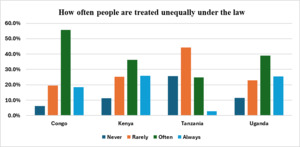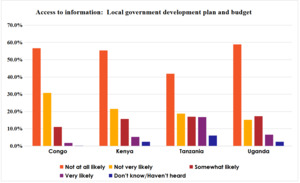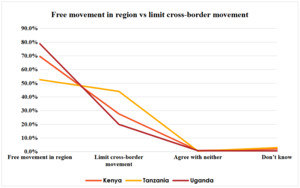Introduction: The Need for Socio-Cultural Integration in the East African Community
The EAC, a regional government organization, originally compromised of Kenya, Uganda and Tanzania (1967). It later expanded to include member states in Burundi (2007), Rwanda (2007), South Sudan (2016), the Democratic Republic of Congo (2022), and Somalia (2023). The EAC has been structured to advance regional integration progressively, with the hope that it will fully realize all four pillars in a Customs Union, a Common Market, a Monetary Union, and eventually a Political Federation. While economic and political integration have been focal points, socio-cultural elements remain underexplored. The Customs Union has promoted economic integration by lowering trade obstacles and promoting free commerce. However, tense interstate ties, old grievances, and little public participation in integration initiatives have hampered deeper political unity that is key for economic advancement (Adar, 2008).
International businesses thrive in liberal economic environments where open markets and multilateralism reduce barriers (Turner, 2024). In saying so, the socio-cultural foundations of the EAC are pivotal for long-term integration success, shaping business interactions, policy alignment, and regional trade. The socio-cultural foundations of the EAC are therefore pivotal in ensuring the long-term success and of further political and economic integration within the region. Consequently, this article derives its insights from the socio-cultural dimensions of Eastafricanness—shared language, history, and identity—which shape among others, business interactions, policy alignment, and regional trade.
Notably, Kiswahili has been promoted as the regional lingua franca. Being the most widely spoken language in East Africa, it serves as a common medium for communication, bridging linguistic barriers between different ethnic groups and countries (Habwe, 2009). The EAC has been proactive about the centralization of Kiswahili through the EAC Kiswahili Commission that monitors and implements Kiswahili programs across the different member states. The promotion of Kiswahili in education, governance, and media solidifies regional identity and fosters cooperation across borders. The widespread use of Kiswahili enhances collaboration among member states by promoting inclusiveness and reducing communication barriers that could hinder integration efforts. Consequently, this linguistic cohesion plays a crucial role in facilitating business prospects and fostering economic growth.
In addition, cultural exchanges through programs such as the EAC Games – competitive events promoting regional unity and cultural exchange among EAC member states through sports – as well as Jama Fest play, an essential role in building trust and social cohesion among East Africans. Such programs offer opportunities for citizens to engage with and learn from one another’s traditions and values, promoting mutual respect and understanding (Khamis & Scully, 2020). These shared experiences allow member states to empathize with one another, fostering solidarity and collective action in addressing regional issues. Moreover, recognising common history helps to create a sense of purpose and shared responsibility in the pursuit of economic development and political stability (Chebet-Choge, 2012).
Integrated societies with strong cultural and social bonds are more likely to engage in cross-border trade, collaborate on resource management, and resolve conflicts amicably. These insights illustrate that when citizens trust one another, it becomes easier to support policies that promote equitable growth and prosperity for all. In comparison, the EU as a regional bloc is testament that cultural cohesion strengthens economic cooperation. The linguistic diversity in the EU is mitigated by structured multilingual policies and shared cultural institutions that foster unity. Therefore, the EAC can adopt similar measures.
While previous studies have examined economic and political integration within the EAC, little attention has been given to the socio-cultural dimension as a key driver of regional success. This article fills that gap by demonstrating how Eastafricanness—through shared identity, language, and cultural alignment—can directly impact international business practices in the region. Without a well-established socio-cultural foundation, businesses operating in the EAC face challenges such as regulatory misalignment, communication barriers, and limited workforce mobility.
Additionally, the lack of socio-cultural cohesion has broader consequences for trade and investment on the African continent. A fragmented regional identity weakens the EAC’s positioning as a trading bloc within Africa, reducing its leverage in negotiations and its ability to attract investors looking for a stable, unified market. If these socio-cultural gaps remain unaddressed, the EAC risks being sidelined in continental and global economic engagements. This is consequential to policymakers who can design more effective regional business policies. Additionally, educators can leverage these insights to train future professionals who will navigate and strengthen the EAC’s economic position.
The dataset in Figure 1 presents the perceptions of citizens from four EAC member states regarding their country’s economic condition post the pandemic period. This underscores the socio-economic disparities that impact regional integration and business confidence.
Eastafricanness: The Missing Foundational Link for Political and Economic Integration
The epistemological discourse on the historical evolution of the EAC integration process is incomplete without addressing the concept of Eastafricanness. Eastafricanness refers to a sense of belonging, identity, and connection to the EAC among its citizens. It embodies a stage where East Africans acknowledge both their individual and collective ownership of the EAC’s purpose (raison d’être), fostering an inclusive attitude toward the entire community. This concept is rooted in a dual social contract: one between each member state and its citizens, and another between East African citizens and the EAC as a collective. Citizen awareness is a conditio sine qua non—an indispensable element—for the regional organization’s existence and for advancing the EAC’s integration agenda. Similar to the dynamics at the national level, the socioeconomic, legal, and political attachment of East African citizens to the EAC is essential for the organization’s sustainability and continuity (Kaburu & Adar, 2020).
Despite this sense of Eastafricanness, socio-cultural divides persist due to disparities in linguistics, education systems, and governance structures inherited from historic colonial legacies. While Tanzania and Kenya have long integrated Kiswahili, Rwanda and Uganda face challenges in widespread adaptation. However, efforts to incorporate Kiswahili into education and governance are ongoing with the aid of the EAC Kiswahili Commission. Kiswahili still remains a unifying factor across the wider EAC as it serves as a common linguistic bridge facilitating communication and cultural cohesion. Despite disparities in its usage, it is still understood and used in varying degrees underpinning its unifying appeal.
Educational disparities also hinder integration in the EAC. Variations in curricula and quality standards limit student mobility and mutual recognition of qualifications. Similarly, fragmented legal, cultural, and governance systems complicate trade and policy harmonization. These differences weaken the region’s ability to present itself as a cohesive bloc in global markets. For instance, business documentation and policies may be written primarily in English or French in some countries, while others emphasize Kiswahili. Therefore, this inconsistency complicates compliance and slows down business processes.
Socioeconomic gaps also create barriers. Urban areas tend to benefit more from integration initiatives than rural communities as they typically have greater access to regional integration projects (Khamis & Scully, 2020), leading to unequal access to opportunities. A lack of shared identity undermines the EAC’s ability to attract foreign investment and establish consistent business standards as the EAC fails to present itself as a cohesive bloc in global trade. Programs like 50MAWS (50 Million African Women Speak), which support women entrepreneurs, have been helpful in trying to bridge economic disparities (The East African Community, 2025). However, more needs to be done. These issues not only hinder regional cohesion but also impede the region’s capacity to engage fully in international business.
The dataset in Figure 2 presents the perceptions of citizens from four EAC member states. Respondents were asked: “In your opinion, how often are people in this country treated unequally under the law?”
The data highlights perceived inequality in legal treatment across EAC member states, pointing to socio-political fractures that hinder collective identity and trust. To address these challenges, beyond harmonizing education, the EAC should emphasize integrated research and learning in areas such as international business, professional business ethics, information technology, and business management. Such initiatives would not only foster regional cooperation but also equip students and professionals with the skills necessary to navigate and thrive in a globalized economy while promoting shared ethical and technological standards across the region. Cohesive societies lower the likelihood of marginalization and promote shared prosperity because they are robust, inclusive, and egalitarian.
While the article portrays that shared colonial histories have provided a basis for unity, deep-seated nationalism and ethnic affiliations often take precedence over regional solidarity. This can create economic and political disparities, affecting equitable distribution of opportunities within the EAC. Addressing these disparities from a socio-cultural perspective requires regional strategies that promote inclusivity and mutual benefits for all member states.
Actionable Strategies for Building Socio-Cultural Foundations in EAC
Support for Nation-Oriented Citizens through the Symbols and Language
Promoting Kiswahili in education and media will foster inclusivity and strengthen regional identity (Habwe, 2009). Its historical role and success thus far in development underlines its unifying potential (Chebet-Choge, 2012). The EAC anthem, flag, and symbols should be widely embraced to unify citizens. Integrating these elements into education and media policies can bridge cultural divides and build a cohesive regional identity. Integrating Kiswahili into educational curricula across member states should help improve cross-border trade and policy coordination.
Integrating Socio-Cultural Exchange Programs with Education
Integrating social and cultural exchange programs into education is vital. Educational harmonization will promote teacher and student mobility, creating a shared regional identity. Case-based learning tailored to local realities will equip students to address regional challenges. This will in turn address inequalities and encourage innovation, further advancing regional unity through shared ideas and cultural exchange (Khamis & Scully, 2020). A unified education system ensures East African graduates meet international standards, boosting the region’s competitiveness in global markets. Once these graduates enter the work force, this will streamline business regulations, easing cross-border operations and reduce trade miscommunication underpinning how interconnected education as a socio-cultural tool is and will be.
Leveraging Media to Promote Regional Trade
Cross-border media partnerships and ethical journalism can enhance regional cooperation. This involves leveraging digital platforms to combat misinformation and promote transparency. Regional media forums will encourage dialogue and grassroots engagement, ensuring stories reflect local realities. Moreover, digital platforms can be utilized to showcase investment opportunities and highlight success stories of businesses thriving within the region. The international business community can then use such platforms to gain market insights, identify trade opportunities, and navigate EAC regulations effectively.
According to Afrobarometer, citizens were asked about their likelihood of obtaining information from government or public institutions regarding their local government’s development plan and budget. The responses in the dataset in Figure 3 reflect varying levels of perceived accessibility to such information across different member states.
Figure 3 reflects the extent to which citizens feel informed about local governance, which directly influences civic engagement and integration legitimacy. However, stronger legislative frameworks and harmonized regulations to support free, responsible journalism and regional solidarity are also paramount. Initiatives such as integrating ICTs, subsidizing community media, and aligning media initiatives with national development goals will enhance accessibility and inclusivity, not least in rural areas.
Regional Women and Youth Empowerment in the EAC
Empowering women and youth is central to the EAC’s integration and development agenda, recognizing their critical role in advancing social, political, and economic growth. Women’s empowerment includes promoting gender equality, combating gender-based violence, and increasing access to resources, leadership, and entrepreneurship opportunities, supported by initiatives like the East African Women in Business Platform (Khamis & Scully, 2020). Youth empowerment focuses on education, skills training, and employment through programs such as the EAC Youth Policy and the East African Youth Network, emphasizing entrepreneurship and youth-led initiatives. These varied programs prepare the different demographics for active roles in trade and commerce. Social-cultural exchanges further integrate young people into the regional development framework by fostering shared cultural and economic values. The dataset in Figure 4 presents responses from respondents regarding whether women and men have an equal chance of obtaining paid employment.
Public views on gender equality in employment opportunities showcase the varying levels of inclusivity, with implications for equitable regional development.
Peace Development Initiatives and Cross-Border Free Movement
Regional security and economic growth are both dependent on stable governance. Free movement of people, goods, and services within the EAC will enhance economic opportunities and investor confidence. Streamlining visa policies, reducing trade barriers, and implementing dispute resolution mechanisms will strengthen regional cohesion and market competitiveness. A stable and peaceful EAC makes the region attractive for foreign investors and international business (Khamis & Scully, 2020). It enhances EAC’s ability to compete on the global market.
The dataset in Figure 5 compares public opinion on free movement across borders versus restrictions on movement. It highlights the level of support for unrestricted cross-border travel against preferences for controlled or limited movement. By implementing these targeted strategies, IB practitioners, policymakers, and businesses can not only benefit from EAC integration but also contribute to building a sustainable and competitive economic bloc that attracts international investment and fosters intra-African trade.
Conclusion
The integration of the EAC hinges not only on political and economic frameworks but also on the recognition and incorporation of socio-cultural factors through Eastafricanness—the creation and operationalization of a shared EAC identity. By embracing these elements, the EAC can foster a more inclusive and sustainable integration process that resonates with its people. A cohesive identity not only strengthens regional unity but also enhances the EAC’s global competitiveness. By presenting itself as a unified economic bloc, the EAC can negotiate trade agreements more effectively and secure a stronger position in international markets. Therefore, the benefits of integration extend both to the regional economy and to the bloc’s global economic engagement.
Acknowledgements
The author gratefully acknowledges Prof. Korwa Adar and Dr. Kaburu for their invaluable guidance and unwavering support throughout this research endeavor. Special thanks are also extended to Mr. Larry Chula for his dedicated and insightful research assistance.
About the Author
Caroline Shisubili Maingi is a lecturer in International Studies and Ethics at Strathmore University. She is also a PhD Candidate in International Relations at the United States International University–Africa, her research focuses on regional integration, foreign policy analysis and ethics. Caroline has participated in programs with Stellenbosch University and St. Gallen University as well as AIB Insights’ Emerging Scholars for Emerging Markets. A recipient of the Kathryn Hoomkwap Award for distinguished service in defending human dignity, she continues to engage in research, teaching, and policy advocacy.










